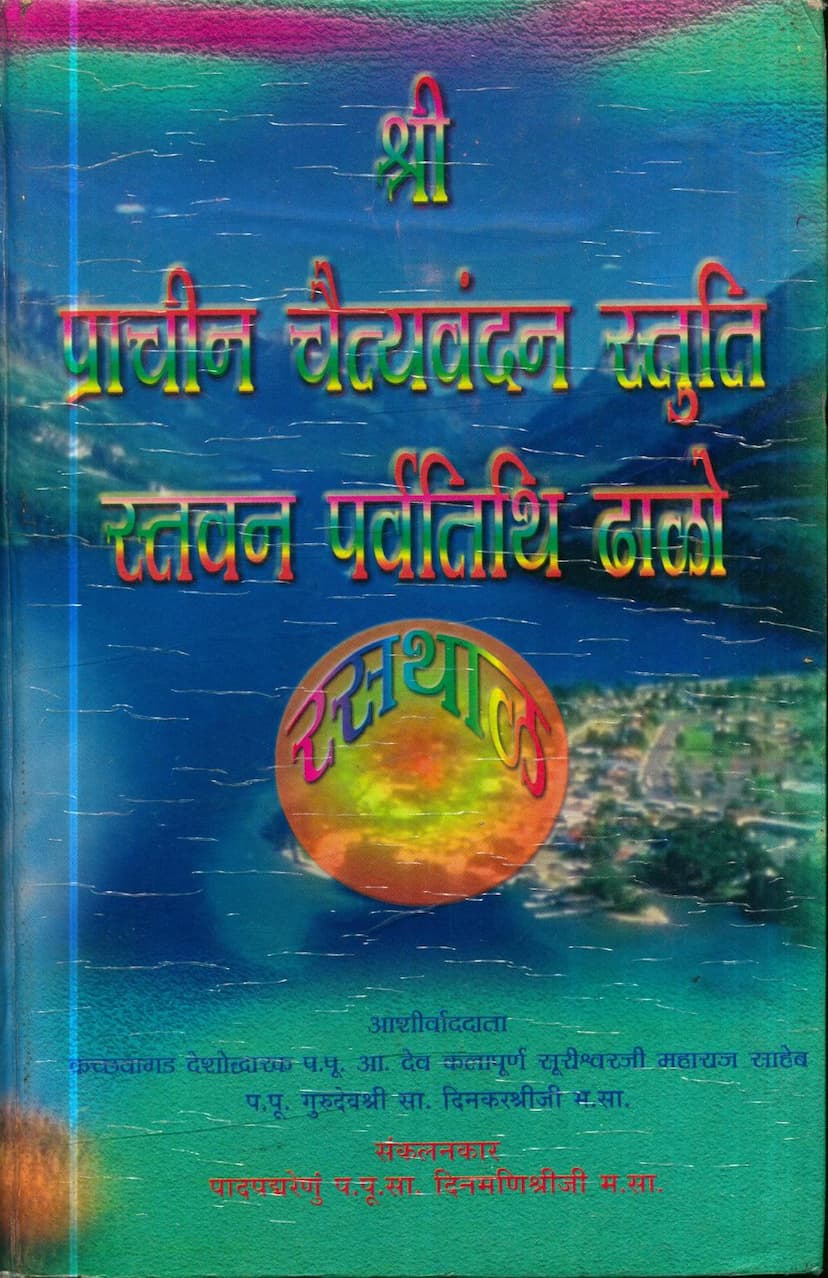Prachin Chaityavandan Stuti Stavan Parvtithi Dhalo
Added to library: September 2, 2025

Summary
Here's a comprehensive summary of the Jain text "Prachin Chaityavandan Stuti Stavan Parvtithi Dhalo" based on the provided pages:
Book Title: Prachin Chaityavandan Stuti Stavan Parvtithi Dhalo (Ancient Temple Salutations, Praises, and Chants for Festival Days)
Author: Sa. Dinmanishreeji M.S.
Publisher: Shriman Seth Shri Dhaneshbhai Pukhrajji Sankariya
Overall Purpose: This book is a collection of devotional hymns, prayers, and verses (Stutis, Stavan, and Dhalos) used in Jain worship, particularly for temple salutations (Chaityavandan), festival days (Parvathithi), and specific occasions. The compilation aims to provide a resource for spiritual practice, focusing on devotion (Bhakti) as a path to connect with the divine and achieve liberation.
Key Themes and Content:
- Devotion (Bhakti) as the Core: The preface and publisher's note emphasize that devotion is a profound and difficult path, requiring a heartfelt connection rather than just intellectual or ascetic practice. Bhakti is presented as the true cardiogram of life, leading to happiness and the resolution of conflicts.
- Praise of Jain Tirthankaras and Gurus: The book is dedicated to various Jain Tirthankaras, including Lord Adinath, Lord Parshvanath, and Lord Mahavir, as well as significant places of pilgrimage like Shatrunjay and Mount Abu. There is also significant praise for the spiritual lineage of Jain monks and nuns, particularly honoring Acharya Shri Vijay Kalapurna Surishwarji Maharaj Saheb and Acharya Shri Vijay Kanakshekhar Surishwarji Maharaj Saheb, as well as the compiler, Sa. Dinmani Shriji M.S. for her diligent work.
- Collection of Devotional Songs: The core of the book comprises a vast collection of various types of devotional songs:
- Chaityavandano (Temple Salutations): These are specific prayers for saluting the idols in Jain temples, often mentioning the particular Tirthankara and the significance of the day or occasion. Examples include salutations for Beej Tithi (a specific auspicious day), Shatrunjay, Lord Simandhar Swami, and various Tirthankaras.
- Stuti (Praise): These are hymns that glorify the virtues, powers, and divine qualities of the Tirthankaras and other revered figures.
- Stavan (Praise and Song): Similar to Stuti, these are often more lyrical and musical praises.
- Parvathithi Dhalo (Verses for Festival Days): These are devotional songs specifically composed for important Jain festivals like Ashtami, Gyana Panchami, and Paryushan. They often describe the significance of the festival and the associated rituals or meditations.
- Emphasis on Indian Languages and Culture: The book is published in Hindi, with an aim to connect the Gujarati-speaking community (particularly of Kachchh-Vagad origin) with devotional practices through the medium of Hindi. The preface highlights the need for Hindi devotional literature across various regions of India.
- Historical and Lineage References: The text frequently mentions important historical figures in Jainism, including various Acharyas and their contributions. It also includes biographical snippets about influential gurus, like Acharya Shri Vijay Kalapurna Surishwarji M.S., highlighting their birth, initiation, and spiritual achievements.
- Structure and Content Breakdown: The table of contents (Page 44-48) reveals a meticulously organized collection, categorizing the verses based on the deity, festival, or type of devotional practice. This includes:
- Chaityavandan Vibhag (Temple Salutations) covering various Tirthankaras and occasions.
- Shri Vishal Stavan Vibhag (Large Section of Praises) dedicated to many Tirthankaras.
- Shri Parvathithi Paryushan Evam Navpadji Dhalo Tatha Sajjayo (Verses for Festival Days, Paryushan, and Navpadji, along with Sajjayas - devotional songs).
- Specific sections for Ashtami, Gyana Panchami, Pariar (Paryushan) festivals, and the nine sacred principles (Navpadji).
- Inclusion of Life Stories: Notably, the book includes detailed biographical accounts, such as the life story of Chandmalji (who later became Acharya Shri Vijay Chandroday Surishwarji M.S.), showcasing the path of renunciation and devotion. It also highlights the contributions of various individuals and families who sponsored the publication, indicating a community effort.
- Spiritual Aspirations: The text often expresses aspirations for spiritual growth, liberation (Moksha), and auspicious rebirths in a way that aligns with Jain philosophy. The foreword includes a prayer for achieving the ultimate goal of spiritual union.
Key Figures Mentioned:
- Sa. Dinmani Shriji M.S.: The compiler, honored for her dedication and spiritual service over 47 years.
- P.P. Acharya Dev Shri Vijay Kalapurna Surishwarji Maharaj Saheb: Revered spiritual guide and inspiration.
- P.P. Acharya Dev Shri Vijay Kalaprabha Surishwarji Maharaj Saheb: Another respected spiritual guide.
- P.P. Acharya Dev Shrimad Vijay Kanak Surishwarji M.S.: An influential Acharya whose life is detailed.
- P.P. Acharya Dev Shri Devendra Surishwarji M.S.: A significant figure in the lineage.
- P.P. Acharya Shri Vijay Chandroday Surishwarji M.S. (Chandanmalji): His life story is presented.
- Various Patrons and Families: Numerous individuals and families are acknowledged for their generous contributions to the publication, underscoring the community's support for this spiritual endeavor.
In essence, "Prachin Chaityavandan Stuti Stavan Parvtithi Dhalo" is a devotional treasury for Jains, offering a rich collection of traditional hymns and praises. It serves as a guide for performing worship, celebrating festivals, and deepening one's connection with the core principles of Jainism, particularly the path of devotion.